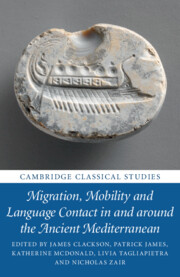Book contents
- Migration, Mobility and Language Contact in and around the Ancient Mediterranean
- Cambridge Classical Studies
- Migration, Mobility and Language Contact in and around the Ancient Mediterranean
- Copyright page
- Dedication
- Contents
- Figures
- Tables
- Contributors
- Acknowledgements
- Abbreviations of Ancient Authors and Works
- Abbreviations of Modern Sources
- Chapter 1 Introduction
- Chapter 2 Interethnic Mobility and Integration in Pre-Roman Etruria
- Chapter 3 Elusive Migrants of Ancient Italy
- Chapter 4 The Language of Mobile Craftsmen in the Western Mediterranean
- Chapter 5 Lost – and Found – in Transmission
- Chapter 6 Mobility and Orthography
- Chapter 7 The Mamertini in Messina
- Chapter 8 Migration, Identity, and Multilingualism in Late Hellenistic Delos
- Chapter 9 Interpretes, Negotiatores and the Roman Army
- Chapter 10 HOC PRIMVS VENIT
- Chapter 11 Population, Migration and Language in the City of Rome
- References
- Index Locorum
- Subject Index
Chapter 6 - Mobility and Orthography
A Contextualisation of Variant Spellings in the Oscan Inscriptions in the Greek Alphabet
Published online by Cambridge University Press: 12 May 2020
- Migration, Mobility and Language Contact in and around the Ancient Mediterranean
- Cambridge Classical Studies
- Migration, Mobility and Language Contact in and around the Ancient Mediterranean
- Copyright page
- Dedication
- Contents
- Figures
- Tables
- Contributors
- Acknowledgements
- Abbreviations of Ancient Authors and Works
- Abbreviations of Modern Sources
- Chapter 1 Introduction
- Chapter 2 Interethnic Mobility and Integration in Pre-Roman Etruria
- Chapter 3 Elusive Migrants of Ancient Italy
- Chapter 4 The Language of Mobile Craftsmen in the Western Mediterranean
- Chapter 5 Lost – and Found – in Transmission
- Chapter 6 Mobility and Orthography
- Chapter 7 The Mamertini in Messina
- Chapter 8 Migration, Identity, and Multilingualism in Late Hellenistic Delos
- Chapter 9 Interpretes, Negotiatores and the Roman Army
- Chapter 10 HOC PRIMVS VENIT
- Chapter 11 Population, Migration and Language in the City of Rome
- References
- Index Locorum
- Subject Index
Summary
Between the fifth and the fourth centuries BC, Oscan-speaking populations from the area of Samnium, in Central Italy, spread into the south of the Italian peninsula; here they came into close contact with the Greeks of Magna Graecia. The Greek language with which Oscan speakers interacted in this area was by no means homogeneous. In fact, the Greeks who had founded colonies in South Italy had come from various areas of mainland Greece and the eastern Mediterranean, and, as a result, the forms of Greek across this region differed significantly: Ionic around the bay of Naples and in Rhegion, on the strait of Messina; Laconian Doric in Taras and its sub-colony Heraclea, both on the Gulf of Taranto; Achaean Doric in a number of colonies in south Campania, Lucania and Bruttium; Northwest Greek in Locri Epizephyrii, in the toe of the Italian peninsula; and possibly Attic-Ionic in Thurii, a Panhellenic colony founded in the fifth century under the leadership of Athens. Then, towards the end of the fourth and the beginning of the third century, the local forms of Greek became increasingly exposed to the influence of the koine, the new ‘standard’ variety of Greek based on the dialect of Athens and employed by the increasingly dominant Macedonians.
- Type
- Chapter
- Information
- Publisher: Cambridge University PressPrint publication year: 2020
- 1
- Cited by

